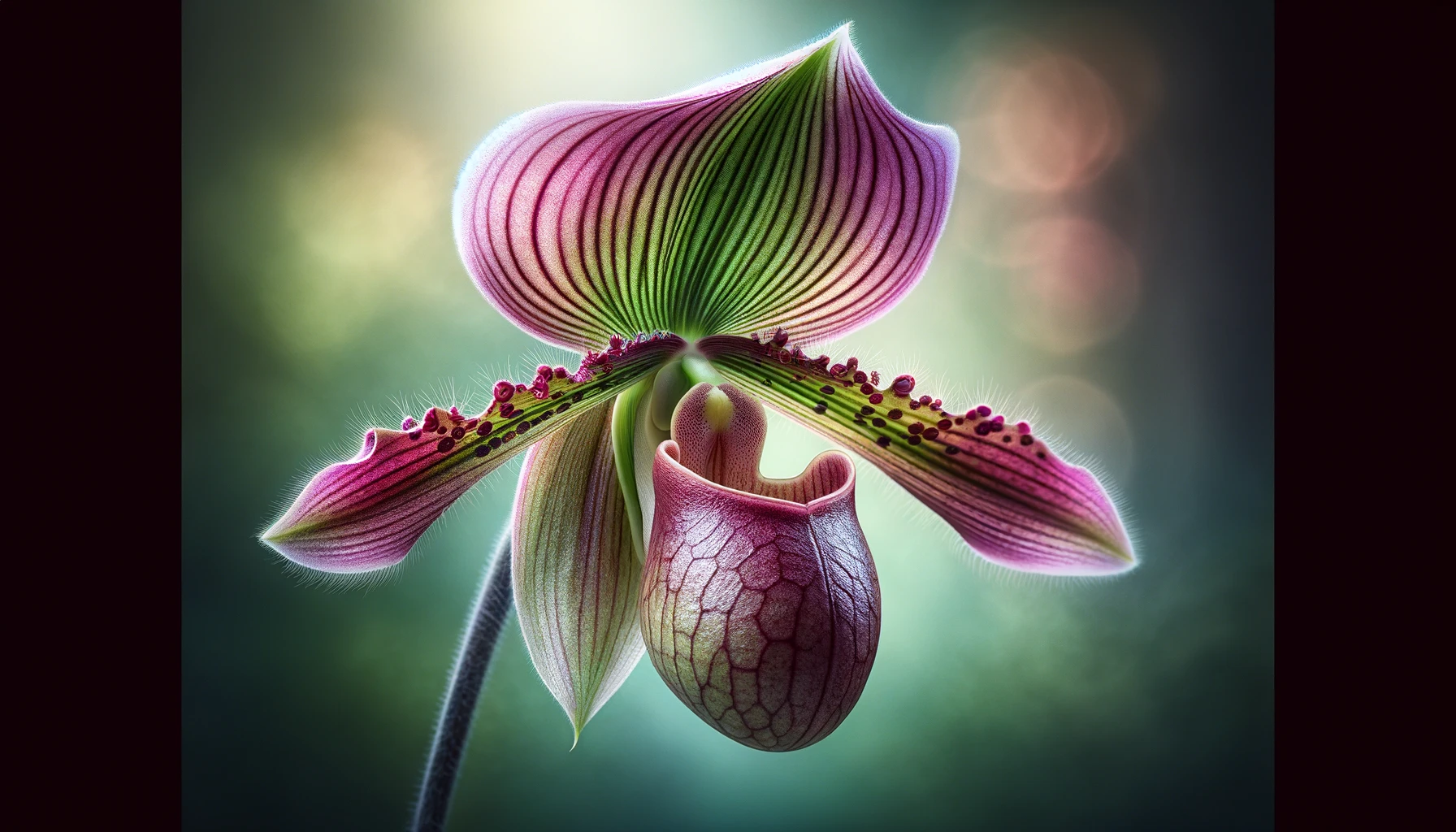
Dive into Paphiopedilum Orchid Care for blooms that dazzle! Explore our easy guide for lush, vibrant flowers.
Key Takeaways:
Paphiopedilum Orchid care involves providing dappled light, consistent moisture without waterlogging, and moderate temperatures ranging from 60-85°F.
A well-draining potting mix and regular fertilization will encourage vibrant blooms and robust health.
Embrace the world of Paphiopedilum Orchid care with our expert tips!
These stunning ‘Lady’s Slippers’ aren’t just a visual treat; they’re a testament to the wonders of diligent care.
Join us as we unravel the secrets to nurturing these captivating blooms.
Introduction: Paphiopedilum Orchid Care

Paphiopedilum orchids, also known as lady-slipper orchids, are a stunning addition to any indoor garden.
These exotic plants are native to the jungles of Southeast Asia and are known for their unique slipper-shaped flowers.
Caring for Paphiopedilum orchids is a rewarding experience, as their vibrant blooms can bring a touch of the tropics to your home.
In this guide, we’ll explore the essentials of Paphiopedilum orchid care to ensure healthy growth and beautiful blooming.
Understanding Paphiopedilum Orchids
Paphiopedilum orchids are part of the Orchidaceae family, which includes over 80 species.
These orchids are terrestrial, growing in the forest floor’s humus, and are known for their distinctive pouch-like flowers.
The name Paphiopedilum comes from Paphos, a city in Cyprus associated with the goddess Aphrodite, and pedilon, meaning slipper, referring to the flower’s shape.
The Importance of Proper Care
Proper care is crucial for Paphiopedilum orchids to thrive.
These orchids have specific needs in terms of light, temperature, water, and humidity.
By providing the right environment, you can enjoy their stunning blooms for an extended period.
Regular care also helps prevent common issues such as pests, diseases, and environmental stress, ensuring your orchids remain healthy and vibrant.
In the following sections, we’ll dive deeper into the specific care requirements for Paphiopedilum orchids, covering everything from light and temperature to watering and fertilization.
Whether you’re a beginner or an experienced orchid enthusiast, this guide will help you create the perfect conditions for your Paphiopedilum orchids to flourish.
Paphiopedilum Orchids Origins
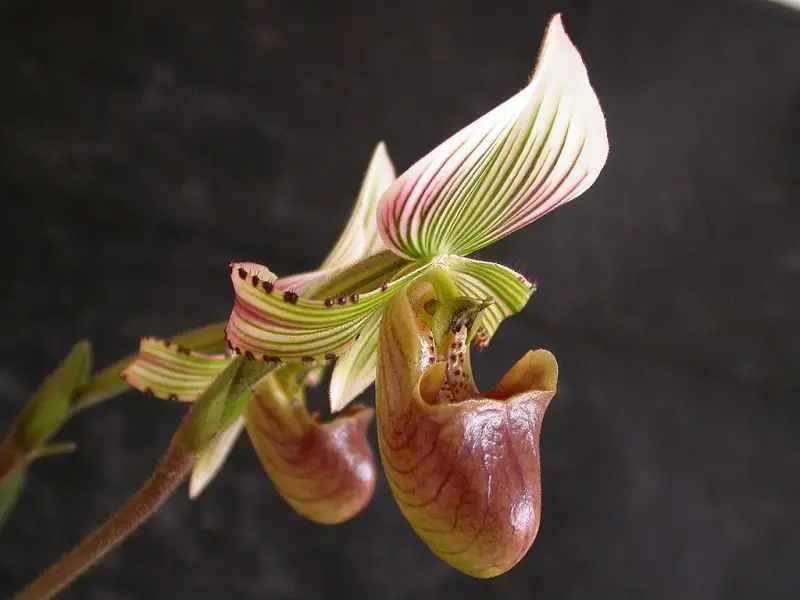
Paphiopedilum orchids, commonly known as lady’s-slipper orchids, are a fascinating group of plants with a rich history and diverse characteristics.
In this section, we’ll explore their origin, natural habitat, and unique features.
Origin and Natural Habitat
Paphiopedilum orchids are native to the tropical and subtropical regions of Southeast Asia, including countries like Indonesia, Thailand, and the Philippines.
They are also found in parts of the Indian Subcontinent, southern China, New Guinea, and the Solomon and Bismarck Islands.
These orchids typically grow in the humid, shaded environments of the forest floor, often in humus or on cliffs in pockets of humus.
Some species are also epiphytes, growing on trees, or lithophytes, growing on rocks.
Characteristics of Paphiopedilum Orchids
Paphiopedilum orchids are known for their unique structure and growth habit.
Here are some key characteristics:
- Flower Structure: The most distinctive feature of Paphiopedilum orchids is their slipper-shaped pouch (labellum), which is part of the flower. This pouch, along with the petals and sepals, creates a striking and exotic appearance. The flowers come in a variety of colors, including green, white, pink, and yellow, often with intricate patterns.
- Leaves: The leaves of Paphiopedilum orchids are typically long and narrow, with some species having mottled patterns. The leaves grow in a fan-like arrangement, providing a lush, green backdrop for the flowers.
- Growth Habit: These orchids are sympodial, meaning they grow horizontally with new shoots emerging from the base of the previous growth. Unlike many other orchids, Paphiopedilum species do not have pseudobulbs for water storage, so they rely on their fleshy roots and constant moisture in the growing medium.
- Root System: The roots of Paphiopedilum orchids are thick and fleshy, adapted to absorb moisture and nutrients efficiently. In cultivation, these roots form a tight mass, which is essential for the plant’s stability and health.
Understanding the origin and characteristics of Paphiopedilum orchids is crucial for providing the right care.
By mimicking their natural habitat as closely as possible, you can ensure that your orchids thrive and produce their stunning blooms year after year.
Light Requirements for Paphiopedilum Orchids
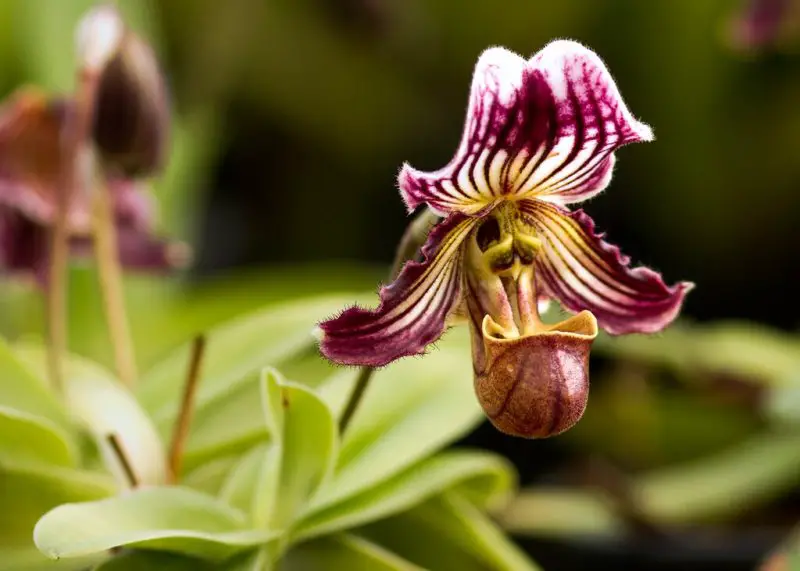
Proper lighting is essential for the health and blooming of Paphiopedilum orchids.
These orchids have specific light requirements that differ from many other types of orchids.
In this section, we’ll discuss the ideal light conditions and tips for providing sufficient light indoors and in greenhouses.
Ideal Light Conditions
Paphiopedilum orchids prefer moderate to low light levels, similar to the shaded environments of their natural habitats. They thrive in:
- Indirect Sunlight: An east or west-facing window that receives gentle morning or afternoon sun is ideal. Avoid direct midday sun, which can scorch the leaves.
- Filtered Light: A shaded south-facing window or a spot that receives filtered light through sheer curtains can also provide suitable conditions.
- Artificial Lighting: In the absence of natural light, fluorescent lighting can be an excellent alternative. Place the orchids 6 to 12 inches below two or four fluorescent tubes for optimal growth.
Tips for Providing Sufficient Light
- Monitor Light Intensity: Use a light meter or your hand to gauge the light intensity. A light level of 1,000 to 1,500 foot candles is ideal. If you can see a faint shadow cast by your hand, the light is likely sufficient.
- Adjust Positioning: Move your orchids closer to or further from the light source to find the perfect spot. Observe the leaves for signs of too much or too little light. Dark green leaves may indicate insufficient light, while yellow or brown spots can signal too much light.
- Rotate Plants: Regularly rotate your orchids to ensure even light exposure on all sides. This helps prevent uneven growth and ensures a balanced display of foliage and flowers.
- Use Sheer Curtains: If your orchids are near a window that receives strong sunlight, use sheer curtains to diffuse the light and protect the plants from direct rays.
- Supplement with Artificial Light: In darker environments or during winter months, supplement natural light with artificial lighting to maintain consistent growth and flowering.
By providing the right light conditions, you can ensure that your Paphiopedilum orchids grow healthy and produce vibrant blooms.
Pay attention to your orchids’ responses to light and adjust their environment as needed to keep them thriving.
Temperature Needs for Paphiopedilum Orchids
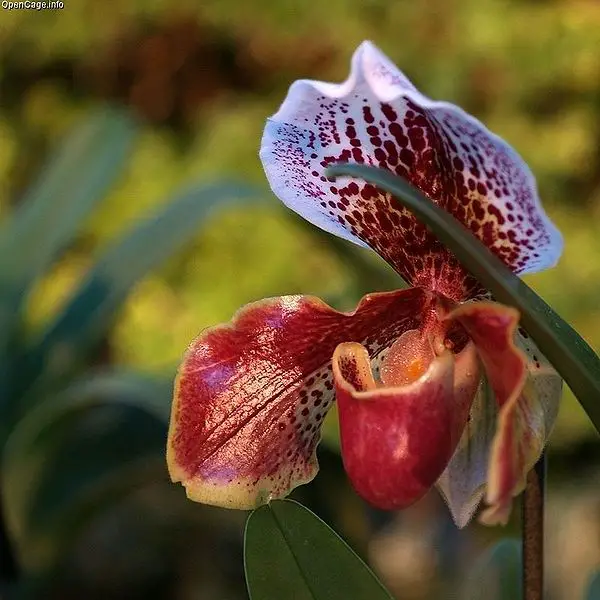
Temperature plays a crucial role in the growth and well-being of Paphiopedilum orchids.
These orchids are classified into two main groups based on their temperature preferences: warm-growing and cool-growing types.
Understanding the optimal temperature ranges for each type and managing temperature fluctuations is key to ensuring healthy growth.
Optimal Temperature Ranges
- Warm-Growing Types: These Paphiopedilum orchids, often with mottled leaves, thrive in warmer conditions. Night temperatures should be between 60°F to 65°F (15°C to 18°C), and day temperatures should range from 75°F to 85°F (24°C to 29°C) or higher.
- Cool-Growing Types: The cool-growing types, typically with green leaves, prefer cooler temperatures. Night temperatures should be between 50°F to 60°F (10°C to 15°C), and day temperatures should be around 75°F to 80°F (24°C to 27°C).
Managing Temperature Fluctuations
- Consistent Environment: Try to maintain a consistent temperature range within the optimal levels for your specific type of Paphiopedilum orchid. Sudden temperature changes can stress the plants and affect their growth and blooming.
- Nighttime Cooling: If you’re growing warm-growing types, ensure that the temperature doesn’t drop too low at night. For cool-growing types, a slight drop in nighttime temperature can be beneficial and mimic their natural habitat.
- Protection from Extremes: In summer, protect your orchids from excessive heat by providing shade or using air conditioning. In winter, keep them away from cold drafts and ensure the temperature doesn’t fall below their preferred range.
- Ventilation: Good air circulation helps regulate temperature and prevents the buildup of heat or cold around the plants. Use fans or open windows to maintain airflow, especially in greenhouses or indoor growing areas.
- Monitoring: Regularly monitor the temperature in your growing area with a thermometer. This will help you make necessary adjustments to maintain the optimal range for your Paphiopedilum orchids.
By paying attention to the temperature needs of your Paphiopedilum orchids and managing fluctuations, you can create an environment that supports their growth and encourages beautiful blooms.
Watering and Humidity for Paphiopedilum Orchids
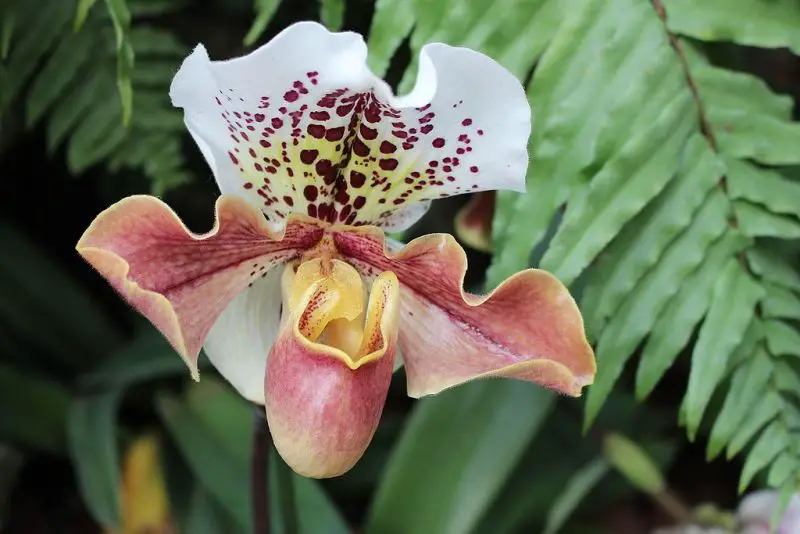
Proper watering and maintaining the right humidity levels are crucial for the health of Paphiopedilum orchids.
These orchids require constant moisture and a moderate level of humidity to thrive. Let’s explore the best practices for watering and humidity control.
Watering Frequency and Techniques
- Consistent Moisture: Paphiopedilum orchids have no pseudobulbs to store water, so it’s essential to keep the potting medium consistently moist. However, be careful not to overwater, as this can lead to root rot.
- Watering Schedule: Water once or twice a week, depending on the temperature, humidity, and the type of potting medium. In warmer conditions, you may need to water more frequently.
- Water Quality: Use room temperature water that is low in minerals. Rainwater or distilled water is ideal. Avoid using softened water, as the salt content can be harmful to the orchids.
- Watering Technique: Water thoroughly, allowing water to run through the potting medium and out of the drainage holes. This ensures that the roots are adequately hydrated and helps flush out any accumulated salts from fertilizers.
Humidity Levels and Methods
- Ideal Humidity: Paphiopedilum orchids prefer a humidity level between 40% and 50%. This mimics the natural humidity of their native habitats.
- Humidity Trays: Place the orchid pots on trays filled with pebbles and water. The water evaporates, increasing the humidity around the plants. Ensure that the pots are not sitting directly in the water to avoid root rot.
- Misting: Lightly mist the orchids in the morning to increase humidity. Avoid misting in the evening, as wet leaves overnight can lead to fungal issues.
- Room Humidifiers: In dry environments, using a room humidifier can help maintain the desired humidity level. Monitor the humidity with a hygrometer to ensure it stays within the optimal range.
- Air Circulation: Ensure good air circulation around the orchids. This helps prevent diseases and allows for an even distribution of humidity. A gentle fan can aid in air movement.
By maintaining constant moisture and the right humidity levels, you can create an ideal environment for your Paphiopedilum orchids to flourish.
Regularly monitor the watering and humidity conditions to ensure your orchids remain healthy and vibrant.
Fertilization for Paphiopedilum Orchids
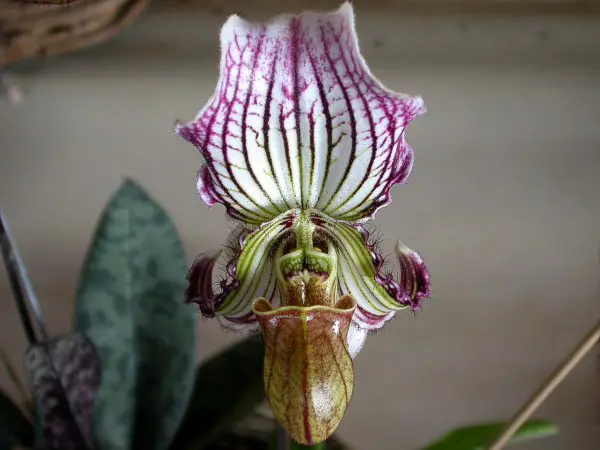
Fertilization is a key aspect of Paphiopedilum orchid care, as it provides the essential nutrients needed for healthy growth and blooming. Here’s what you need to know about fertilizing these orchids:
Recommended Fertilizers
- High-Nitrogen Fertilizers: Use a high-nitrogen fertilizer (such as 30-10-10) when your Paphiopedilum orchids are potted in a fir-bark mix. This type of fertilizer provides the nitrogen necessary for leaf and root growth.
- Balanced Fertilizers: If your orchids are potted in a different medium or if they are in active growth, you can use a balanced fertilizer (such as 20-20-20) to provide a more even distribution of nutrients.
Feeding Schedule
- Warm Weather: During the growing season (spring and summer), fertilize your Paphiopedilum orchids every two weeks with a half-strength solution of the recommended fertilizer. This frequent feeding supports the increased growth and energy demands of the plant.
- Cool Weather: In the cooler months (fall and winter), reduce fertilization to once a month. The orchids’ growth slows down during this time, so they require fewer nutrients.
- Flushing: Regardless of the season, it’s important to flush the potting medium with clear water once a month to leach out any excess fertilizer salts that may have accumulated. This prevents root burn and ensures a healthy root environment.
Importance of Regular Fertilization
See orchid fertilizers on Amazon
Nutrient Supply: Regular fertilization provides the necessary nutrients for your Paphiopedilum orchids to grow, bloom, and maintain healthy foliage.
- Encourages Blooming: Adequate fertilization supports the development of strong flower spikes and vibrant blooms.
- Prevents Nutrient Deficiencies: Consistent feeding helps prevent nutrient deficiencies that can lead to stunted growth, discolored leaves, and poor flowering.
By following a regular fertilization schedule and using the appropriate fertilizers, you can ensure that your Paphiopedilum orchids receive the nutrients they need for optimal growth and beautiful blooms.
Always follow the instructions on the fertilizer package and adjust the feeding schedule based on your orchids’ specific needs and environmental conditions.
Potting and Repotting Paphiopedilum Orchids
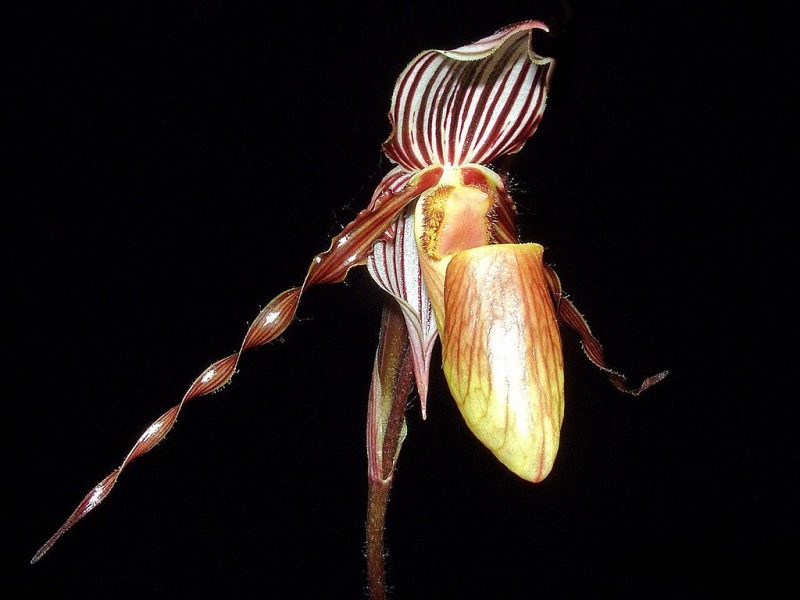
Choosing the right potting mix and knowing when and how to repot are crucial for the health of Paphiopedilum orchids.
Let’s explore the best practices for potting and repotting these beautiful plants.
Suitable Potting Mixes
See orchid potting mixes on Amazon
Fir Bark Mix: A fine- or medium-grade fir bark mix is commonly used for Paphiopedilum orchids. It provides good drainage and aeration, which are essential for healthy root growth.
- Additives: To improve moisture retention and drainage, you can add perlite (sponge rock), coarse sand, and sphagnum moss to the fir bark mix. The ideal mix should hold moisture well while allowing excess water to drain quickly.
- Specialty Orchid Mixes: There are also commercial orchid mixes available that are specifically formulated for Paphiopedilum orchids. These mixes often contain a blend of bark, perlite, and other ingredients to create an optimal growing environment.
Pot Sizes
- Choosing the Right Size: Paphiopedilum orchids do not like to be overpotted. Choose a pot that is just large enough to accommodate the roots and provide a little room for growth. An average-sized plant typically requires a 4- to 6-inch pot.
- Drainage: Make sure the pot has adequate drainage holes to prevent water from pooling at the bottom, which can lead to root rot.
When and How to Repot
- Timing: Repot your Paphiopedilum orchids every two years or when the potting medium begins to break down and lose its drainage capacity. Seedlings and smaller plants may need to be repotted annually.
- Steps for Repotting:
- Remove the Orchid: Gently take the orchid out of its old pot and carefully remove any old potting mix from the roots.
- Trim Damaged Roots: Use sterilized scissors or clippers to trim away any dead or rotting roots.
- Prepare the New Pot: Place a layer of fresh potting mix at the bottom of the new pot.
- Position the Orchid: Place the orchid in the pot and spread the roots over the potting mix. The junction of the roots and stem should be buried about 1/2 inch deep in the center of the pot.
- Add Potting Mix: Fill in around the roots with more potting mix, gently tapping the pot to settle the mix without compacting it too tightly.
- Water and Care: Water the orchid thoroughly after repotting and continue with your regular care routine.
Repotting is a vital part of Paphiopedilum orchid care, as it refreshes the growing environment and gives the orchid the best chance for healthy growth and blooming.
By following these guidelines, you can ensure your orchids thrive in their new pots.
Pests and Diseases Affecting Paphiopedilum Orchids
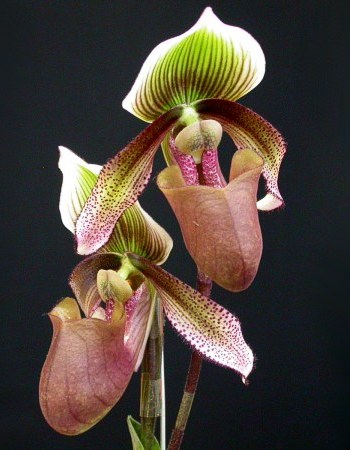
Paphiopedilum orchids, like all plants, can be susceptible to pests and diseases.
Early detection and proper treatment are key to keeping your orchids healthy.
Let’s look at some common issues and how to address them.
Common Pests
- Spider Mites: These tiny pests can cause yellowing and stippling on leaves. To treat, wash the leaves with water and apply a miticide or neem oil.
- Mealybugs: These white, cottony pests suck sap from the orchids. Remove them with a cotton swab dipped in rubbing alcohol or use insecticidal soap.
- Scale Insects: These pests attach themselves to leaves and stems, causing yellow spots. Scrape them off or treat with horticultural oil or insecticidal soap.
Common Diseases
- Root Rot: Caused by overwatering or poor drainage, root rot can be fatal. Prevent it by ensuring proper watering and drainage. Treat affected plants by removing rotten roots and repotting in fresh medium.
- Leaf Spot: Fungal or bacterial leaf spots appear as discolored areas on the leaves. Improve air circulation, reduce humidity, and remove affected leaves. Apply a fungicide or bactericide if necessary.
- Crown Rot: This is a serious condition where the base of the leaves and the crown of the plant rot, often due to water sitting on the plant. Avoid getting water in the crown and treat with a fungicide if detected.
Prevention and Treatment Methods
- Good Hygiene: Regularly clean your growing area and tools to prevent the spread of pests and diseases.
- Quarantine New Plants: Keep new orchids separate from your existing collection for a few weeks to monitor for any issues.
- Regular Inspection: Check your orchids regularly for signs of pests or diseases. Early detection is crucial for effective treatment.
- Proper Watering: Overwatering is a common cause of disease. Water your orchids appropriately, allowing the potting mix to dry slightly between waterings.
- Adequate Air Circulation: Ensure good air movement around your orchids to reduce humidity and prevent fungal diseases.
By being vigilant and proactive in your care, you can prevent most pests and diseases from affecting your Paphiopedilum orchids.
If you do encounter any issues, address them promptly to keep your orchids healthy and thriving.
Flowering and Blooming in Paphiopedilum Orchids
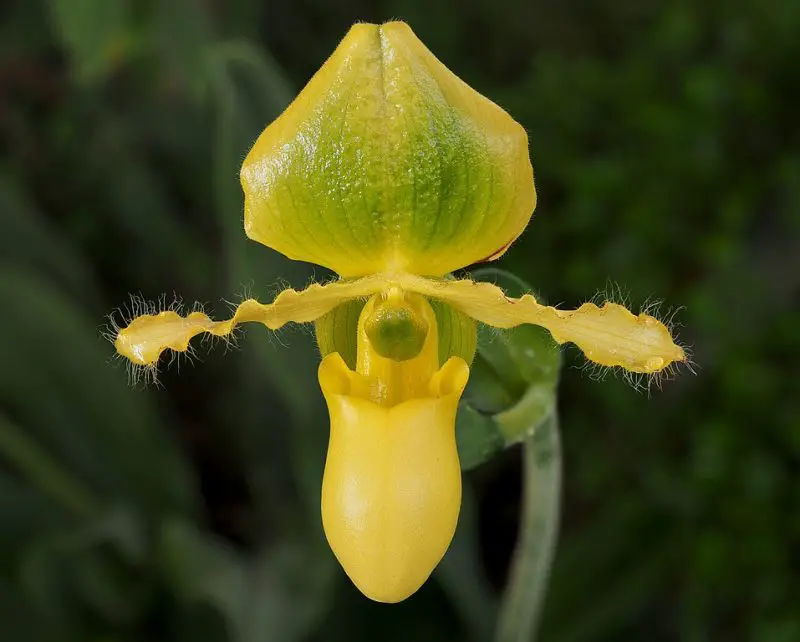
Paphiopedilum orchids are prized for their beautiful and unique blooms.
Understanding the factors that influence flowering and following some tips can help you encourage regular and healthy blooms in your orchids.
Factors Influencing Blooming
- Light: Adequate light is crucial for blooming. Paphiopedilum orchids prefer moderate light levels. Too little light can result in lush foliage without flowers, while too much light can cause leaf burn.
- Temperature: Temperature fluctuations between day and night can trigger blooming in Paphiopedilum orchids. Warm-growing types need higher temperatures, while cool-growing types prefer cooler conditions.
- Watering: Consistent moisture is important, but overwatering can lead to root rot and inhibit blooming. Allow the potting mix to dry slightly between waterings.
- Fertilization: Regular fertilization with a balanced fertilizer supports overall plant health and encourages blooming. Reduce fertilizer frequency during the cooler months when growth slows.
- Potting Mix and Pot Size: A well-draining potting mix and a correctly sized pot are essential for healthy root growth, which in turn supports blooming.
Tips to Encourage Regular and Healthy Blooms
- Provide Rest Periods: After blooming, Paphiopedilum orchids benefit from a rest period with reduced watering and fertilization. This helps them gather energy for the next blooming cycle.
- Repotting: Repot your orchids every two years or when the potting mix breaks down. Fresh potting mix and a clean environment can invigorate the plant and encourage blooming.
- Maintain Health: Keep your orchids healthy by monitoring for pests and diseases and addressing any issues promptly. A healthy plant is more likely to produce vibrant blooms.
- Mature Plants: Paphiopedilum orchids typically bloom when they are mature and have several growths. Be patient with younger plants as they may take a few years to reach blooming size.
By understanding the factors that influence blooming and following these tips, you can enjoy regular and healthy blooms from your Paphiopedilum orchids.
Remember that each orchid has its own rhythm and may not bloom on a strict schedule.
Enjoy the process of caring for your orchids, and the beautiful blooms will be a rewarding bonus.
Propagation of Paphiopedilum Orchids
Propagation is a great way to expand your Paphiopedilum orchid collection.
While these orchids are not as easily propagated as some other plants, there are still methods you can use to successfully grow new plants.
Let’s explore these methods and some tips for successful propagation.
Methods for Propagating Paphiopedilum Orchids
- Division: This is the most common method for propagating Paphiopedilum orchids. When repotting, you can divide the plant into smaller sections, each with at least three to five growths (fans of leaves). This ensures that each division has enough energy to establish itself and eventually bloom.
- Back Bulbs: Some Paphiopedilum orchids produce back bulbs, which are older, leafless growths that can be used for propagation. Remove these back bulbs with a sharp, sterilized knife and pot them separately. With proper care, they may produce new growths and eventually flower.
- Seed Propagation: Propagating Paphiopedilum orchids from seed is challenging and typically done by professional growers. Orchid seeds require specific fungal associations to germinate, and the process is usually carried out in sterile laboratory conditions.
Tips for Successful Propagation and Growth
- Sterilize Tools: Use sterilized tools when dividing or cutting the plant to prevent the spread of disease.
- Proper Potting: Pot each division in a suitable potting mix and pot size for Paphiopedilum orchids. Ensure good drainage and aeration for healthy root development.
- Optimal Conditions: Provide the newly potted divisions with the same optimal growing conditions as mature plants, including appropriate light, temperature, humidity, and watering.
- Patience: Be patient, as it may take a year or two for the divisions to establish and bloom. Back bulbs may take even longer to produce new growth.
- Regular Care: Continue with regular care, including fertilization and pest and disease monitoring, to support the growth and health of the new plants.
Propagation through division is a rewarding way to increase your Paphiopedilum orchid collection and share these beautiful plants with friends and fellow enthusiasts.
With the right care and patience, your new orchid divisions will thrive and eventually reward you with their stunning blooms.
FAQs: Paphiopedilum Orchid Care
Caring for Paphiopedilum orchids, also known as Lady’s Slipper orchids, raises many questions among enthusiasts.
These exotic plants, with their unique slipper-shaped flowers, require specific conditions to thrive.
In this FAQ section, we address common inquiries about light requirements, blooming frequency, general care, and more.
By understanding the needs of Paphiopedilum orchids, you can ensure their health and enjoy their stunning blooms for years to come.
Q. How much light do Paphiopedilum orchids need?
A. Paphiopedilum orchids prefer low to moderate light conditions. They do well in slightly shaded east, south, or west windows. If exposed to too much direct sunlight, the leaves may develop a reddish tinge, indicating sunburn. A medium green leaf color is ideal for these orchids.
Q. How often do Paphiopedilum orchids bloom?
A. Paphiopedilum orchids typically bloom once a year, with the exact timing depending on the species and growing conditions. The blooms can last from a few weeks to a few months.
Q. How do you take care of a Paphiopedilum?
A. Care for Paphiopedilum orchids involves providing low to moderate light, maintaining temperatures between 60-85°F for warm-climate types and 50-80°F for cool-climate types, ensuring high humidity levels (40-50%), watering about once a week to keep the potting mix moist but not soggy, and using a well-draining potting mix suitable for the specific species.
Q. How do I get my Paph to bloom?
A. To encourage blooming, provide Paphiopedilum orchids with the right growing conditions, including a well-draining orchid mix, indirect light, consistent moisture, and a slight temperature drop during the night. Ensure the orchid is mature enough, as some varieties may not bloom until they reach a certain age.
Q. Do Paphiopedilum only bloom once?
A. Paphiopedilum orchids typically bloom once per year, but the duration of the bloom can vary from a few weeks to a few months.
Q. How long does it take for a Paphiopedilum to bloom?
A. The time it takes for a Paphiopedilum orchid to bloom can vary depending on the species and growing conditions. Generally, they bloom once a year, with flowers lasting from a few weeks to a few months.
Conclusion: Mastering Paphiopedilum Orchid Care
Caring for Paphiopedilum orchids, with their enchanting blooms and distinctive slipper-shaped flowers, is a rewarding journey for any plant enthusiast.
By adhering to the key care principles outlined in this guide, you can ensure the health and vibrancy of these exotic plants.
Recap of Key Points for Successful Paphiopedilum Orchid Care
- Light: Provide low to moderate light, avoiding direct sunlight to prevent leaf burn.
- Temperature: Maintain temperatures between 60-85°F for warm-climate types and 50-80°F for cool-climate types.
- Humidity: Aim for 40-50% humidity, using humidity trays or humidifiers if necessary.
- Watering: Keep the potting mix consistently moist but not soggy, watering about once a week.
- Fertilization: Use a balanced fertilizer regularly during the growing season, reducing frequency in the dormant period.
- Potting and Repotting: Use a well-draining potting mix and repot every two years or as needed.
- Pest and Disease Management: Regularly inspect your orchids and address any issues promptly.
Encouragement for Readers to Enjoy the Beauty of These Unique Orchids
As you embark on your Paphiopedilum orchid care journey, remember that patience and attention to detail are key.
These captivating plants may require a bit of extra care, but the reward of their stunning blooms is well worth the effort.
Embrace the process, and let the beauty of Paphiopedilum orchids bring a touch of the exotic to your home or garden.
Orchid Types: Discover an Astonishing Variety of Orchids
Resources for Paphiopedilum Orchid Care
Embarking on the journey of caring for Paphiopedilum orchids can be both exciting and challenging.
To help you navigate this journey, we’ve compiled a list of authoritative, non-commercial resources.
These websites offer a wealth of information on the proper care and maintenance of these unique and beautiful orchids.
- Smithsonian Gardens Orchid Care Sheets: Smithsonian Gardens provides detailed care sheets for Paphiopedilum orchids, covering all aspects of their cultivation.
- American Orchid Society: The American Orchid Society offers a comprehensive guide on Paphiopedilum orchid care, including tips on watering, light, temperature, and more.
- Royal Horticultural Society: The Royal Horticultural Society provides expert advice on growing and caring for orchids, including Paphiopedilum varieties.
- Missouri Botanical Garden: The Missouri Botanical Garden offers an informative profile on Paphiopedilum orchids, including their characteristics and care requirements.
These resources are excellent starting points for both novice and experienced orchid enthusiasts.
They offer valuable insights into the specific needs of Paphiopedilum orchids, helping you ensure their health and beauty for years to come.
Read more: Orchid Types: Discover an Astonishing Variety of Orchids
This post contains affiliate links.

